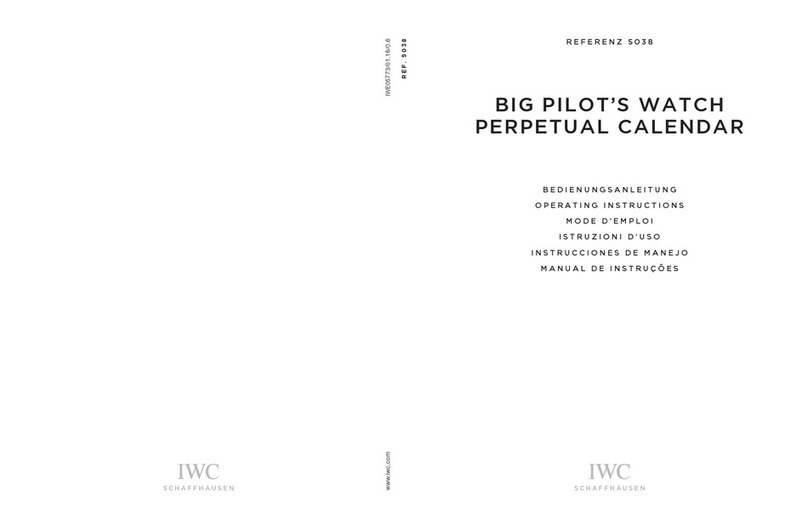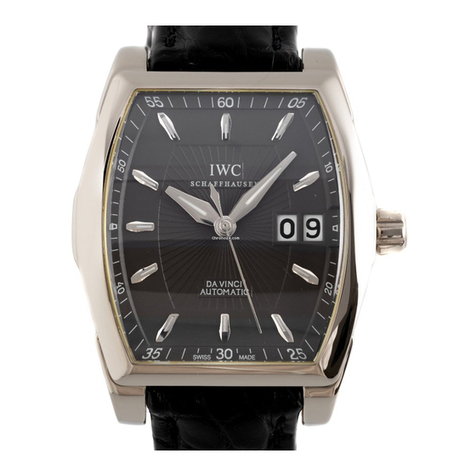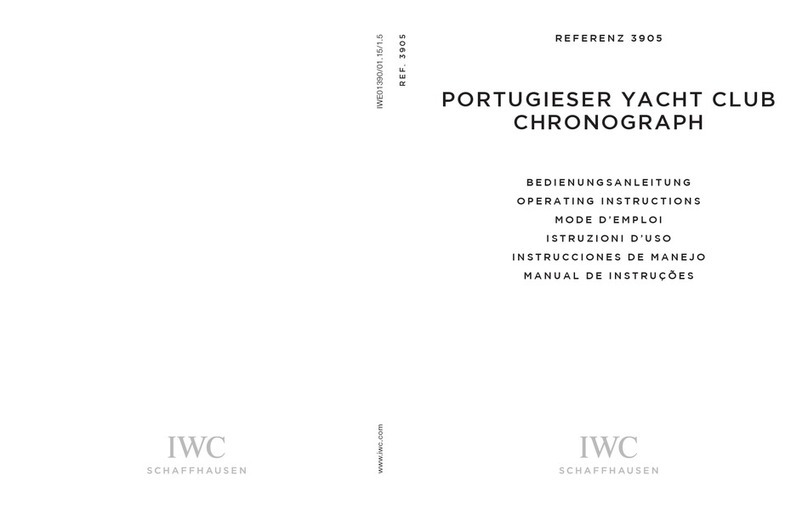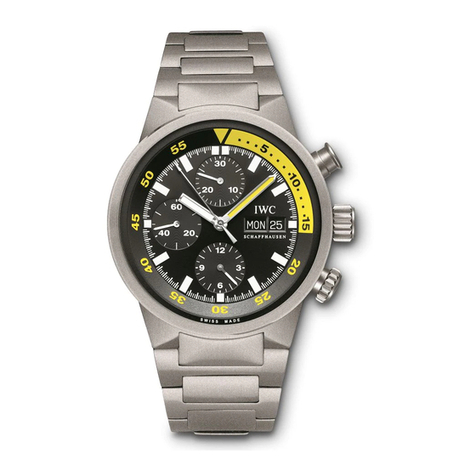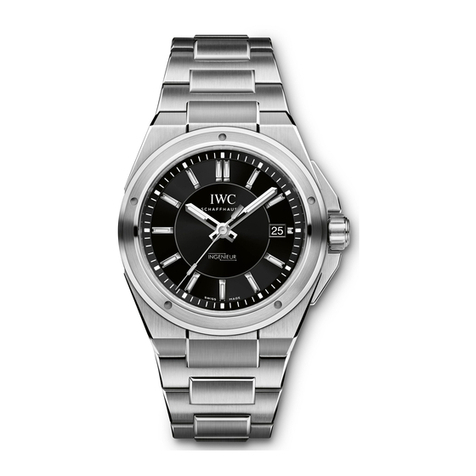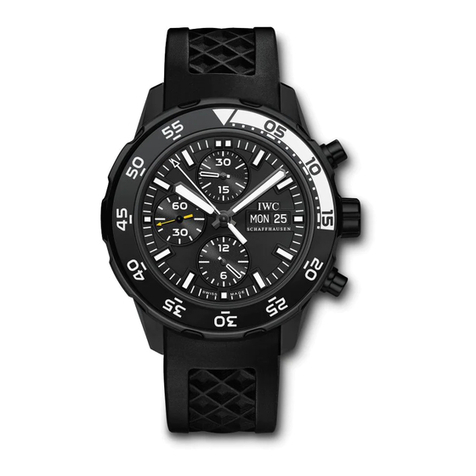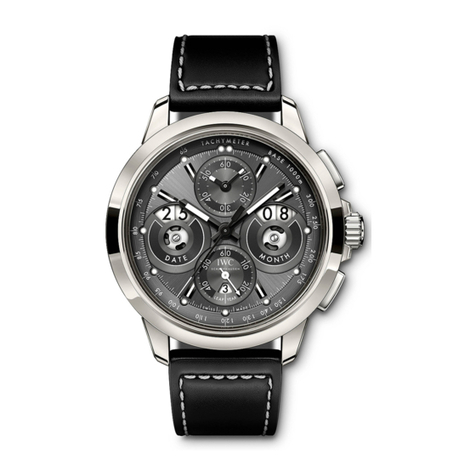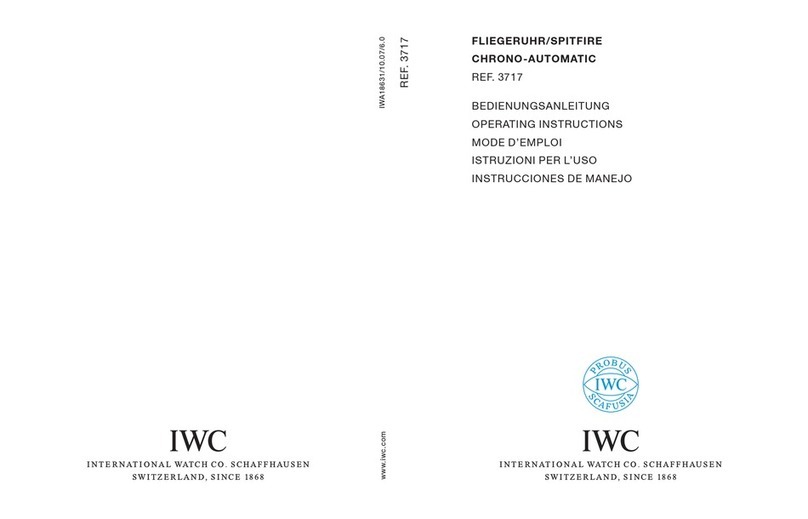
INGENIEUR PERPETUAL CALENDAR DIGITAL DATE-MONTH INGENIEUR PERPETUAL CALENDAR DIGITAL DATE-MONTH
— 14 — — 15 —
Das Einstellen beim Überschreiten von Zeitzonen:
– Beim Überschreiten von Zeitzonen in östlicher Richtung stellen Sie die Uhrzeit einfach vorwärts auf
die neue Ortszeit ein.
– Werden Zeitzonen in westlicher Richtung überschritten, können Sie die Zeiger Ihrer Uhr rückwärts
auf die aktuelle Tageszeit einstellen. Nicht überschreiten dürfen Sie dabei das Ende der Schalt-
phase des Kalendariums, also 2 Uhr morgens. Ergibt sich diese Situation, müssen Sie bei einer
Reise nach Westen die Ortszeit Ihres Reiseziels bereits vor 22 Uhr einstellen. Sie dürfen die Zeiger
nicht zwischen 22 und 2 Uhr zurückstellen. Der Grund liegt darin, dass das Kalendarium beim
Rückwärts drehen der Zeiger über Mitternacht hinweg nicht um einen Tag zurückschaltet, sondern
auf demselben Tag verbleibt. Überschreiten Sie also beim Rückwärtsstellen der Zeiger das Ende
der Schaltphase des Kalendariums (2 Uhr morgens), dann riskieren Sie, dass das Kalendarium ein
zweites Mal um einen Tag vorschaltet und somit einen Tag zu viel anzeigt.
Das Einstellen beim Überschreiten der Datumsgrenze:
– Beim Überschreiten der Datumsgrenze in westlicher Richtung (Sie springen in den nächsten Tag,
egal zu welcher Tageszeit) stellen Sie die Uhrzeit einfach vorwärts auf die neue Ortszeit ein, die
Datumsschaltung erfolgt automatisch.
– Beim Überschreiten der Datumsgrenze in östlicher Richtung (Sie springen in den gestrigen Tag,
egal zu welcher Tageszeit) müssen Sie die Uhr ebenfalls vorwärts auf die neue Ortszeit einstellen.
Jetzt zeigt Ihre Uhr allerdings das falsche Tagesdatum an (einen Tag zu viel). Diese Datumsfehl-
anzeige kann mit zwei Zeigerrückstellungen von jeweils 12 Stunden korrigiert werden:
– Die erste Rückstellung um 12 Stunden erfolgt am Nachmittag zwischen 14 und 22 Uhr; damit
verhindern Sie das Weiterschalten des Kalendariums um Mitternacht.
– Die zweite Rückstellung um 12 Stunden erfolgt am nächsten Vormittag zwischen 2 und 11 Uhr;
damit ist die Datumsanzeige wieder synchron zum Ortsdatum.
Warnhinweis:
Sollte Ihre Uhr zwischen 22 Uhr und 2 Uhr stehen geblieben sein, dürfen Sie auf keinen Fall
die Datumsschnellschaltung in Position 1 der Krone verwenden, um das Datum zu korrigieren.
Die Folge wäre eine Beschädigung einer Komponente im Kalendermechanismus, die eine Reparatur
durch einen Uhrmacher erforderlich macht.
HINWEIS ZU MAGNETFELDERN
Aufgrund der immer höheren Verbreitung von sehr starken Magneten aus Seltenerdlegierungen
(beispielsweise Neodym-Eisen-Bor) in den letzten Jahren – diese kommen u. a. in Gegenständen
wie Lautsprechern und Mobiltelefonen sowie in Verschlüssen von Schmuck und Handtaschen vor–
können mechanische Uhren beim Kontakt mit solchen Magneten magnetisiert werden. Dieser Vorgang
